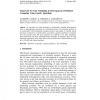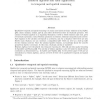AIR
2005
14 years 2 months ago
2005
Abstract. This paper presents the new DDAC4 algorithm for dynamic arc consistency enforcement in distributed Constraint Satisfaction Problems. The algorithm is an adaptation of the...
AIR
2005
14 years 2 months ago
2005
A desired capability of automatic problem solvers is that they can explain the results. Such explanations should justify that the solution proposed by the problem solver arises fr...
AIR
2005
14 years 2 months ago
2005
An algorithm has been developed to dynamically schedule heterogeneous tasks on heterogeneous processors in a distributed system. The scheduler operates in an environment with dynam...
AIR
2005
14 years 2 months ago
2005
Most users of machine-learning products are reluctant to use the systems without any sense of the underlying logic that has led to the system's predictions. Unfortunately many...
AIR
2005
14 years 2 months ago
2005
In case-based reasoning (CBR) approaches to product recommendation, descriptions of the available products are stored in a case library and retrieved in response to a query represe...
AIR
2005
14 years 2 months ago
2005
Abstract. We present an overview of different theories of explanation from the philosophy and cognitive science communities. Based on these theories, as well as models of explanati...
AIR
2005
14 years 2 months ago
2005
As software organisations mature, their repositories of reusable software components from previous projects will also grow considerably. Remaining conversant with all components in...
AIR
2005
14 years 2 months ago
2005
The scientific research in the area of computational mechanisms for trust and reputation in virtual societies is a recent discipline oriented to increase the reliability and perfor...
AIR
2005
14 years 2 months ago
2005
Qualitative temporal and spatial reasoning is in many cases based on binary relations such as before, after, starts, contains, contact, part of, and others derived from these by r...
AIR
2005
14 years 2 months ago
2005
The paradox of fuzzy modeling is recognized due to the co-existence of its effectiveness of solving uncertain problems in the real world and the skepticism of its reasonability in ...



